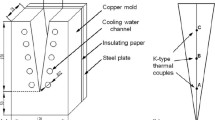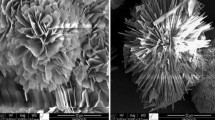Abstract
In-situ transmission electron microscopy in combination with a heating stage has been employed to real-time monitor variations of δ-phase MnO2 nanoflowers in terms of their morphology and crystalline structures upon thermal annealing at elevated temperatures up to ∼665 °C. High-temperature annealing drives the diffusion of the small δ-MnO2 nanocrystallites within short distances less than 15 nm and the fusion of the adjacent δ-MnO2 nanocrystallites, leading to the formation of larger crystalline domains including highly crystalline nanorods. The annealed nanoflowers remain their overall flower-like morphology while they are converted to α-MnO2. The preferred transformation of the δ-MnO2 to the α-MnO2 can be ascribed to the close lattice spacing of most crystalline lattices between δ-MnO2 and α-MnO2, that might lead to a possible epitaxial growth of α-MnO2 lattices on the δ-MnO2 lattices during the thermal annealing process.
Similar content being viewed by others
References
Wei W, Cui X, Chen W, Ivey DG. Manganese oxide-based materials as electrochemical supercapacitor electrodes. Chem Soc Rev, 2011, 40: 1697–1721
Lang X, Hirata A, Fujita T, Chen M. Nanoporous metal/oxide hybrid electrodes for electrochemical supercapacitors. Nat Nanotechnol, 2011, 6: 232–236
Thackeray MM. Manganese oxides for lithium batteries. Prog Solid St Chem, 1997, 25: 1–71
Thackeray MM, David WIF, Bruce PG, Goodenough JB. Lithium insertion into manganese spinels. Mater Res Bull, 1983, 18: 461–472
Débart A, Paterson AJ, Bao J, Bruce PG. α-MnO2 nanowires: A catalyst for the O2 electrode in rechargeable lithium batteries. Angew Chem Int Ed, 2008, 47: 4521–4524
Bruce PG, Freunberger SA, Hardwick LJ, Tarascon JM. Li-O2 and Li-S batteries with high energy storage. Nat Mater, 2012, 11: 19–29
Devaraj S, Munichandraiah N. Effect of crystallographic structure of MnO2 on its electrochemical capacitance properties. J Phys Chem C, 2008, 112: 4406–4417
Brousse T, Toupin M, Dugas R, Athouel L, Crosnier O, Belanger D. Crystalline MnO2 as possible alternatives to amorphous compounds in electrochemical supercapacitors. J Electrochem Soc, 2006, 153: A2171–A2180
Wang X, Yuan A, Wang Y. Supercapacitive behaviors and their temperature dependence of sol-gel synthesized nanostructured manganese dioxide in lithium hydroxide electrolyte. J Power Sources, 2007, 172: 1007–1011
Gao T, Fjellvag H, Norby P. Structural and morphological evolution of beta-MnO2 nanorods during hydrothermal synthesis. Nanotechnology, 2009, 20: 055610 (7)
Ye C, Lin ZM, Hui SZ. Electrochemical and capacitance properties of rod-shaped MnO2 for supercapacitor. J Electrochem Soc, 2005, 152: A1272–A1278
Yu P, Zhang X, Chen Y, Ma Y. Solution-combustion synthesis of ɛ-MnO2 for supercapacitors. Mater Lett, 2010, 64: 61–64
Ragupathy P, Park DH, Campet G, Vasan HN, Hwang SJ, Choy JH, Munichandraiah N. Remarkable capacity retention of nanostructured manganese oxide upon cycling as an electrode material for supercapacitor. J Phys Chem C, 2009, 113: 6303–6309
Zhou M, Zhang X, Wei J, Zhao S, Wang L, Feng B. Morphology-controlled synthesis and novel microwave absorption properties of hollow urchinlike α-MnO2 nanostructures. J Phys Chem C, 2011, 115: 1398–1402
Xu M, Kong L, Zhou W, Li H. Hydrothermal synthesis and pseudocapacitance properties of α-MnO2 hollow spheres and hollow urchins. J Phys Chem C, 2007, 111: 19141–19147
Author information
Authors and Affiliations
Corresponding author
Electronic supplementary material
Rights and permissions
About this article
Cite this article
Sun, Y., Liu, Y., Truong, T.T. et al. Thermal transformation of δ-MnO2 nanoflowers studied by in-situ TEM. Sci. China Chem. 55, 2346–2352 (2012). https://doi.org/10.1007/s11426-012-4688-5
Received:
Accepted:
Published:
Issue Date:
DOI: https://doi.org/10.1007/s11426-012-4688-5




